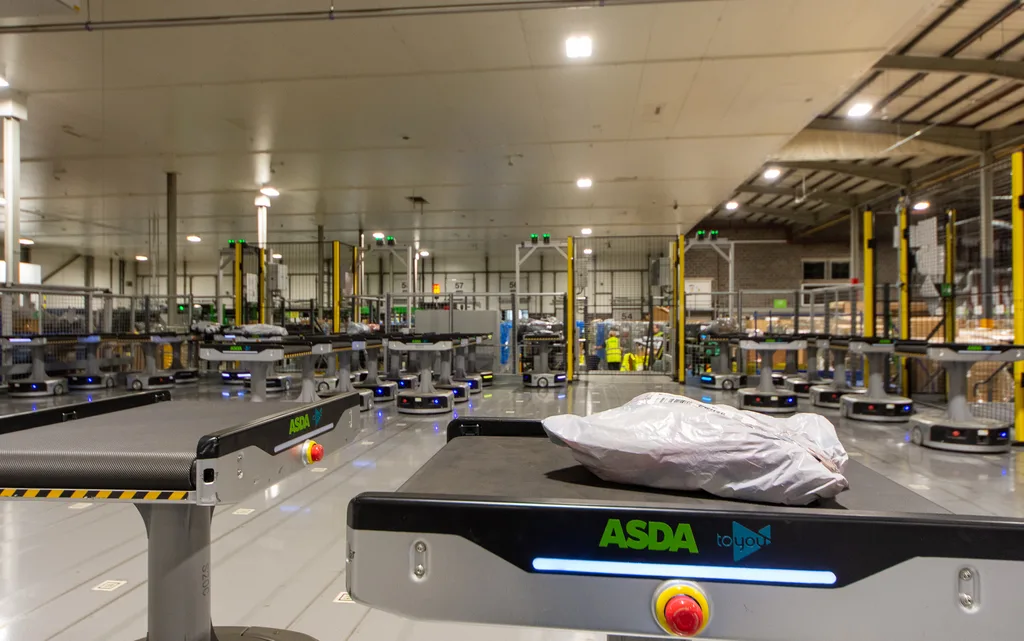Interrogate your options
The retail sector has always pushed the boundaries of automation in the warehouse, and this has gifted occupiers more control and efficiency. But the journey is far from over, and it is important to interrogate the solutions on offer, whether it is the flexibility of modular solutions, or how exactly data can add value. HSS editor Simon Duddy reports.

WE WILL look at a number of trends in this feature from how the economic picture is impacting the warehouse, to nitty-gritty approaches that are refining how companies deal with the challenges of throughput, whether in the warehouse, the micro-fulfilment centre, or elsewhere. We’ll also illustrate how increased warehouse automation need not create a carbon burden, and can be managed through on-site power generation.
As we prepare for Peak, it looks likely that less money will be spent by consumers compared to previous years. ParcelHero head of consumer research, David Jinks, says: “Our research suggests consumers will have £4bn less this Christmas to spend than last, which closely matches the £4.4bn cut in spending predicted by Retail Economics/Metapack. There is also ongoing disruptions. Lockdowns in Chinese port cities Ningbo, Shanghai and Tianjin are already hitting worldwide supply chains.”
There are also challenges closer to home, illustrated by the much-lauded online pure-play retailer ASOS hitting choppy waters, with reports that it plans to write off more than £100m of stock after growth stalled and share price dipped, in the face of ‘significant inflationary pressures across labour, freight and delivery costs, with elevated inventory levels and an increase in returns’.
{EMBED(1243214)}
In addition, online furniture retailer Made.com recently entered administration. While these are extreme examples, for retailers, margins are getting squeezed by the combined effect of cautious consumer spending and product cost increases. As a consequence, retailers are looking at reducing operational costs and reliance on labour.
BearingPoint partner Emile Naus, explains: “Automation is one area that is booming as a consequence. The objective of automation is almost always to remove activities that do not add value, such as walking and waiting time.”
Shift
Automation in retail warehouses is not a new area, with more than 20 years’ experience by various retailers, but there has recently been a shift in the available technology, and broadly speaking there are two options.
The traditional, large-scale method involves typically a new site, with significant investment in storage and handling systems. Often, these systems use some form of goods-to-person system to remove walking time (as much as possible) from the process. They offer a very good future solution with significant reduction in operating costs, but can be capital intensive and typically take a number of years to install.
Emile Naus adds, however, that automated systems have evolved significantly in recent years.
“We’ve seen the introduction of more modular systems that can typically be added to existing operations. There are a number of potential solutions, from shelf carrying robots to robots that accompany an operator as part of their pick assignment. These systems are typically lower investments, and sometimes are commercially offered as a rental solution.”
{EMBED(1243215)}
A good example of the fast impact of these solutions is with Hong Kong based eComm focused 3PL Stork Up. It deployed mobile robots from Geek+, taking just 12 days for hardware implementation.
Geek+ VP and managing director, overseas business Lit Fung, says: “We are committed to making AMRs simpler to use and easier to adopt.” Stork Up adds the bots allowed them to increase the accuracy and efficiency of the pick and pack process by up to 300%.
Emil Naus explains: “While the newer technology is more flexible than some of the traditional systems, care should be taken to ascertain the level of flexibility that is required. For instance, if the system uses totes to store or move products, the size of the products could have a huge effect on the efficiency of the system. If product dimensions are well known and not likely to change, that may not be an issue, but in a more dynamic environment, it could lead to significant challenges in the future.”
Working with a systems integrator with a broad range of skills and experience, across warehousing should help.
{EMBED(1243216)}
Logistex robotics solutions specialist Nigel Lahiri says: “With so many options available, the question is; which is the right AMR technology, or combination of technologies, that will deliver the greatest value for your operation? Also, how do you integrate these technologies with your existing systems and processes?
“The answer is to work with a systems Integrator that has a broad view of the technologies available, and has the skills to model and simulate a variety of concepts. A systems integrator will use data analysis to design the most suitable solution controlled by a software platform (WCS) which has the capability to orchestrate tasks across a range of flexible and traditional automation, as any combination of these could be appropriate.”
Naus adds: “In terms of successful introduction of automation, it is key to be really clear on the objectives. What is the purpose of the operation, and how might automation support that? Too often, automation becomes the focus rather than the method of achieving the objective. Ultimately, automation works best if it is blended into the end-to-end operation, with a seamless integration of manual, semi-automated and fully automated systems.”
Integration
Thoughtful integration was a crucial consideration when Currys elected to revamp its supply chain. This was behind its partnership with GXO Logistics, which took effect prior to Peak 2021. GXO is supporting the electrical retailer in a three-year ‘Brilliant Basics’ plan to overhaul its supply chain and service operations business and strengthen the Omnichannel experience. GXO operates four distribution centres for Currys in the UK and Ireland, as well as its omnichannel fulfilment and returns logistics.
Currys chief operating officer Lindsay Haselhurst, says: “Partnering with GXO to run our UK warehouse operations was a great decision. The company plays a key role in the success of our ‘Brilliant Basics’ plan, which we designed to improve our supply chain and service operations. Our customers expect the best online and in-store experience, and GXO is helping us meet and even exceed their expectations. We’re looking forward to continued success with GXO in the years ahead.”
GXO retail business director Peter Fuller explains: “Currys has used automated warehouse technology before, but we have brought a more systematic approach to the technology into play.

“It’s not just about the technology itself, we have thought a lot about how the technology impacts processes and staff, and spent time working with staff to make sure they were ready to embrace the changes that the technology brings. This applies not just to the warehouse staff but also to store staff, who, for example, may have to adjust to different delivery schedules.”
GXO Logistics has a foot in ‘both camps’ when it comes to automated warehouse technology.
Peter continues: “We can provide large scale automation projects, such as with Nestle at the East Midlands Gateway, where we worked in partnership with both Nestle and the automation system integrator Swisslog.
“However, these large scale systems require long lead times and a lot of planning. We see more potential for modular automation technology, such as AMRs, which can be quick to implement and have high impact.”
Data
It is also clear that any type of automation is reliant on good data and effective systems.
Emile Naus continues: “In a manual process, it is not untypical for operators to ‘work around the process’ to get things done or to be more efficient, but in an automated world that is simply not possible. We have seen many examples where poor systems design has caused issues, because it was designed around the standard process, without consideration for the exceptions that certain customers or products require.”
Data is certainly making a difference in retail logistics. Retailers are seeking detail to help to quickly analyse and improve operations.
Asda put together a logistics operation for its toyou third-party collection and returns service, running out of the Asda Logistics Services (ALS) DC at South Elmsall in West Yorkshire.
The facility has Geek robots running alongside conveyors, and much else, with AMH Material Handling the integrator. The overall solution is described as Logistics 4.0 in action.
Data has been crucial in getting the best out of the automated sorting solution, which puts an emphasis on accurate and robust bar-code scanning.

Emile Naus, BearingPoint
Asda Yorkshire cross-dock centre general manager Adam Mydlowski, explains: “Every barcode is recorded via the warehouse control system, so we can interrogate each individual scanner, and go through every barcode.
“We can take a full download of that and search for a particular order. We can fully track the system to find out if a parcel is scanned, or if it has not been scanned at all.
“Once we begin to fully utilise the data that is collected, it becomes powerful. Good reads, no reads, throughput error messages and downtime – that’s all useful information.
“For example, if there is a particular infeed that keeps stopping, I can investigate to see if the problem lies with the scanner, belt, operator or the barcode, that is helping us to get the most out of the whole operation. We have been able to really deep dive to achieve continuous improvements.”
Asda solved the parcel label reading challenge with two SICK Lector 652 image-based code readers positioned in a framework at the top of each conveyor. The SICK cameras read the barcode before the parcel transfers to a waiting robot.
Data will also prove crucial in taking steps towards the fully automated warehouse of the future.
Integrator Element Logic has developed a cloud-based data platform – eLogiq – to pull in more and better data to gain insight into warehouse operations, and better execute warehouse processes.
Technology director Sutharshan Nadarajah says: “There is valuable data in our customers' warehouse solutions, and eLogiq collects and structures it in a database. The data exists in multiple sources, including Element Logic's other software solutions, eManager, eOperator, and eController. Our software is combined and used for data-driven optimisation.”
eLogiq will shortly include a dashboard solution displaying processed key data based on KPIs. Anticipated future services include predictive analysis of goods flow and data harvesting to document sustainability, risk management, and regulatory requirements.
Micro-fulfillment centres (MFCs)
The impact of online technology had a slower burn on groceries than general retail, for obvious reasons, but the pandemic forced the industry over a threshold, so that even as e-grocery volumes have receded there is now a much-more established expectation and business rationale for it.
Indeed, Walmart’s recent acquisition of automated e-grocery fulfillment provider Alert Innovation suggests retailers sense a major opportunity. Alert Innovation has been working with Walmart to customise technology for Walmart’s market fulfillment centres (MFCs) since 2016.
Research firm Styleintelligence says: “Retailers buying warehouse automation vendors has been uncommon, but there is precedence. In 2012, Amazon acquired Kiva Systems for $775m, withdrew the robots from general sale, and laid the foundation for what is today Amazon Robotics.”
It continues: “Online grocery in the US became a landgrab opportunity; whoever gets there first may be the future leader.”
Much grocery fulfillment is carried out manually, with people picking from supermarket for dark stores to fill baskets for onward delivery via either van or bike. But one route to better efficiency may be automation.
A respondent to a research paper on micro-hubs completed by the EHI Retail Institute in Germany, suggested that micro-hub success was more dependent on a sufficiently high throughput of goods, as opposed to size or location of hub.
This suggests that space efficient automated technologies could help drive the throughputs needed to meet demand, although efficiencies are also required in loading and delivery. It will defy simple, broad sweep answers though.
Swisslog’s Bob Hoffman says grocers have learned two important lessons about automating eGrocery fulfillment close to customers since the concept first attracted widespread attention in 2020.
The first is that automating eGrocery fulfillment is more complex than many expected. The other is that, for many, automation is becoming unavoidable.
He says: “The challenge of squeezing automation into a small space to support local fulfillment was only the most obvious of the many that must be addressed in what is essentially a fundamental shift in how grocers serve their customers.
“One of the signs of how far it has come is the fact that picking orders can now be considered the easy part of an MFC implementation. Not that optimising picking is simple, but it must be supported by efficient replenishment processes and sophisticated order sequencing, consolidation and staging processes to achieve success with automated local fulfillment. The best practice is to take a holistic approach to fulfillment processes.”
eGrocery brings its own challenges in other words. Although it is technically a form of eCommerce, from an order fulfillment standpoint, an eGrocery fulfillment centre operates very differently from an eCommerce warehouse.
Bob explains: “eComm functions on batch fulfillment processes based on shipping schedules. In eGrocery, orders must be fulfilled continuously based on pickups and deliveries that occur throughout the day. You’re also managing fulfillment from ambient and chilled automation as well as manual picking of frozen foods, fast moving items and long-tail items, so a level of sophistication in order consolidation is required in eGrocery that isn’t present in eCommerce.”
Energy
Increased automation in the warehouse suggests additional draw on the electricity grid. But a recent implementation carried out kidswear retailer Childrensalon has caught the eye, with its automated logistics solution powered by rooftop solar panels. Innovative stuff.
The retailer selected Swisslog and opted for an AutoStore solution at its facility in Royal Tunbridge Wells. When complete, the solution will offer 50 robots; 42,500 storage bins; seven remote decant stations; and eight carousel pick stations.
Childrensalon has many initiatives to protect the environment and the entire automated logistics solution functions on solar powered energy.
The Swisslog is energy-efficient solution comes under its GreenLog initiative. The AutoStore solution contributes to this initiative with each robot using just 100W of energy per hour.
The retailer’s group Co-CEO Asher S. Harriman-Smith, explains: “Sustainability is important to us at Childrensalon. We endeavour to implement green practices wherever possible throughout our entire organisation and we are incredibly pleased this is reflected in the warehouse environment. Swisslog has provided a first-class solution and continues to support us as our business requirements change.”
Conclusion
We have looked at a number of trends in this feature. In the face of economic tightening, demand should fall, but perhaps paradoxically it will not necessarily ease labour shortages very much, which may mean warehouse automation technologies continue to find a value proposition.
We’ve also seen how Childrensalon has taken innovative steps to a greener, less power hungry automated warehouse, and we have also seen how the evolving use of data promises to provide an underpinning for more precise and predictable warehousing in the future.






